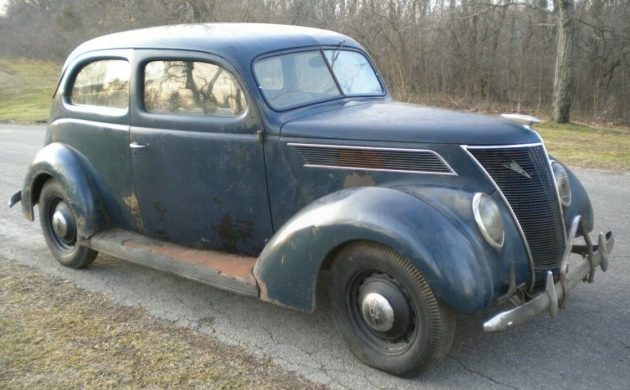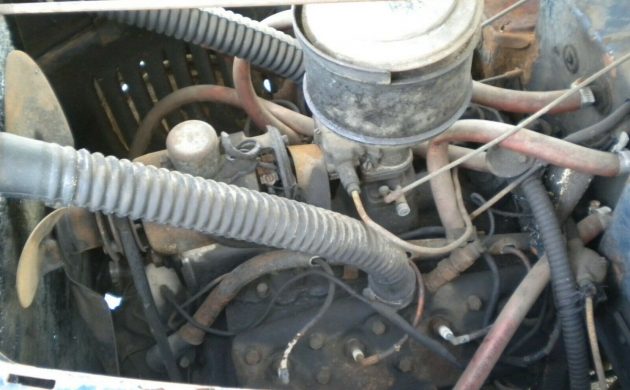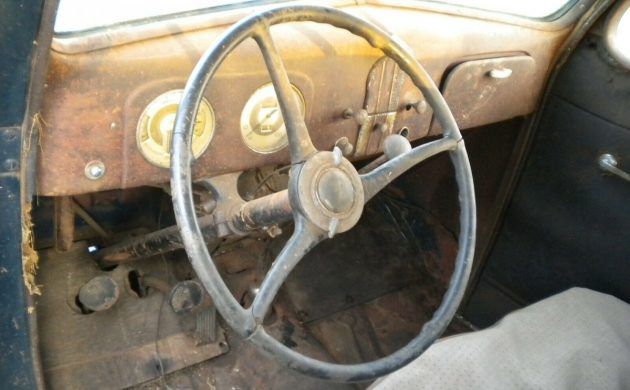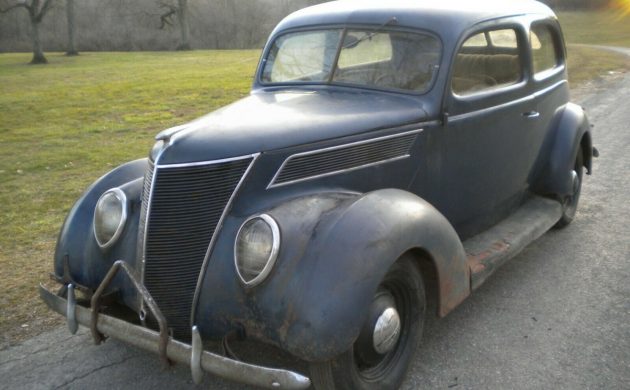The Ford Motor Company developed some iconic car designs in the 1930s, largely thanks to the work and influence of Henry Ford’s son, Edsel Ford, and E.T. “Bob” Gregorie. Edsel, Gregorie, and another automotive designer named Johan “Jan” Tjaarda worked together on new Ford/Lincoln car designs, and in 1936, the Lincoln Zephyr debuted as one of the first successful streamlined car designs of the 1930s. Capitalizing on the acclaim of the Zephyr, Ford redesigned their passenger car lineup for the Standard and DeLuxe to resemble the Lincoln. This 1937 Ford Tudor “Slantback” is one of 400,000 sold that model year. Located in Cincinnati, Ohio, here on eBay bidding is spirited. That is no surprise given the claimed barn find status and 20,410 original miles! Currently bidding at $4,600 with no reserve, this car is definitely selling.
1937 was a year of firsts for Ford. It was the first year of body integrated headlights and all steel roofs compared to the vinyl insert used in earlier models. It was also the first year the company offered their 60 horsepower, 136 cubic inch flathead V8, the smaller cousin of the 85 horsepower, 221 cubic inch V8 that came out in 1932. Although the 136 was a decent engine, American buyers preferred the larger 221 for it’s greater power and torque. The 1937 Fords were offered in the same two levels of trim as previous years, Standard and DeLuxe. Henry Ford also had an impact on the design of these cars. Originally, the designed length was to be 182.75 inches, but Henry dictated that it should be shortened to 179.5 inches, leaving the proportions looking slightly off. 1938 models would go back to the 182.75 overall length. Interestingly, Henry also insisted on mechanical steel cable brakes, whereas rival Chevrolet had introduced hydraulic brakes in their cars the year before.
Judging by the interior and its single tail lamp, this 1937 Ford is a Standard model, and it certainly falls into the category of survivor. According to the seller, this car is all original, with low miles and the original title. The paint is Washington Blue, with spots of rust on the rear fenders and near the rear bumper. The engine turns over freely, and the car was supposedly driven into the barn where it sat for the last 30 years. I can’t be sure, but it’s possible this car was the 60 horse, 136 cu in V8. The floors and chassis are said to be in good condition as well. It is odd that the interior almost seems to be in a worse state than the exterior, with missing or partially destroyed door panels and surface rust throughout. Of note is the heater mounted underneath the dash, indicating that this car has likely lived its entire life in the north of the country. All the gauges are intact and in great shape with seemingly little wear. All of the exterior glass is in excellent condition, with only a little of the delamination common in barn finds of a similar era.
This car truly is a time capsule, and from the condition, it’s possible that it is truly a low mileage example; once the new owner goes through the mechanical parts of the car and checks for wear, that should either be confirmed or disproven. Either way, it is a great candidate for a partial restoration of the mechanicals, electrics, and some of the interior, leaving the original paint as is. While not the most desirable body style made in ’37, that shouldn’t stop this car from being a great driver and potential preservation class award winner at car shows. What do you think? Is this ’37 Ford for you, or would you give it pass for something else?





It’s at 8100 when I just checked. Seems high for what it is, but it is a pretty neat car, especially if the condition is not overstated and the mileage can be verified
Neat car. This one I’d make a restomod out of. Build it and drive it and have fun with it.
No argument on the “neat car” part …
My father had a 60hp std model slantback which he bought when he graduated high school in 1940 .He parked it in a garage when he joined the service soon after 12/7 . When he came home in 1946, he had a new wife with him, and the car served them both well until the 1949 Fords came out. Suddenly the little Ford looked (and was ) very outdated , and my dad bought a new 49 coupe . The 37 Ford was sold to a guy for $25.00 that raced it at Thompson Speedway. A sad end for a car, but probably better than going straight to a junkyard .
The farm boys used to say that if you put a corn cob in front of all four wheels of a sixty it wouldn’t have enough power to move. The engine was too small for the heavy body. It did well in European applications, however, and was used into the fifties.
If you follow the history of Hot Rodding ,you can note ,it really became a viable entity after WWll, and some what of an organization with ideas and rules, although they were not carved in stone, they were just understood and loosely adheared too. The 37 Ford’s seemed to fall into this structure and that was 37’s were not viable for Hot Rodding.
For some reason the 37’s remained “The Stepchild ” of early Ford’s Hot Rods, into the 70’s or even 80’s. As the inventory of early Ford’s was being depleted, the negativity toward this Ford started to gain a following, mostly because they had been ignored for so long and also some creative builders, built some really cool cars, such as 37 Delivery’s, Cabriolet’s, Roadster’s (the last Ford Rdstr) and all of a sudden the ugl was duckling became the White Swan.
These cars are still cheaper than other years and model’s , but certainly can be a great car depending on what your build plan is.
Rode to Lake Michigan with a childhood friend’s grandparents in the fifties in one identical to this one which is a little over a hundred mile round trip. A survivor for going on 80 years it would be a shame to hot rod it.
Indeed.
Oooh, oooh, oooh!!! Had I not just bought a 1930 Tudor, I may have jumped on this one! Love it, and it has a Phlattie too!!!
I just checked the price at 10;15 am pacific time, it is sitting at $4,750. I’d love to have this and leave it looking exactly like it is, maybe build a hopped up Merc flattie and an overdrive tranny
It has the 221 85 hp flathead in this one. One of the cars I regret not buying was about 20 years ago when I went to look at a ’40 Ford in Illinois that I didn’t buy, but on the way home I stopped at a small museum in Galena, IL. There was a ’37 Tudor identical to this one with the V-8 60 in it. I don’t remember if it was restored or original because it looked like new. It was for sale and I offered $7000 for it but they were stuck on $8000, so I walked away. I have always regretted that so much I bought a Washington Blue ’37 Ford Cabriolet last year.
https://photos.app.goo.gl/TuLZRruqC23quUsh8
Warren Stieg (above) echoed the same story my dad had told many years ago. That was one reason why these cars had 4:11 & 4:44 rear end gears (plus that beautiful tubular front axle). Dad also said the 60s got worse gas mileage as well – not a good selling point (new or used) in the Great Depression. But put that V8-60 engine (and gear set) into something more lighter in weight (a T-bone or A-bone conversion or a smaller race car) and watch out!
There is a lot of wear on the right hand running board for a car with supposedly so little miles on it.Being l/h/d the driver would i imagine get in on the other side.
I have a 4 door sedan with 140,000 miles on it,owned since 1978 and my left side running board is 100 times better than whats shown in the photo.
I have known my car for more years than i have owned it.
I would still like to own this one as mine is a 4 door flatback.